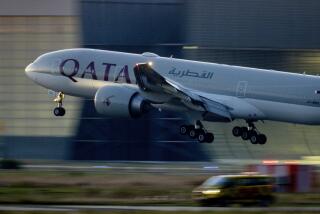Problems reported before deadly plane crash in Spain
- Share via
MADRID — It was a troubled flight from the beginning. One attempt at takeoff was aborted. Departure was delayed by more than an hour. Passengers, many of them parents traveling with their young children, were grumpy and hot, eager to get on with it, to start their holidays in the alluring Canary Islands.
Several used their cellphones to call relatives and report the problems. Finally, they said by phone, the flight was going to take off.
It tried. But seconds after Spanair Flight JK5022 barreled down a new runway at Madrid’s Barajas airport and began to lift off, the jet jerked to the right and plowed into a tree-covered ravine. The fuselage broke into two pieces, maybe more, witnesses at the airport said, and burst into flames.
At least 153 people were killed in the deadliest accident at the ultramodern airport in a quarter of a century. Nineteen people, including two children, survived.
“I pulled out about seven people alive,” said Francisco Cruz, a private pilot who was among the people pressed into rescue service. “And then it was all dead bodies.”
The accident was also the latest among mounting woes for Spanair, the Spanish unit of Stockholm-based SAS and Spain’s second-largest carrier.
Spanair executives said it was too early to pinpoint the cause of the crash, but, as the passengers indicated, there were numerous signs that the plane, a 15-year-old U.S.-made McDonnell Douglas MD-82, had technical problems.
Spanair spokesman Sergio Allard said at a news conference that the aircraft had passed a routine inspection in January. He said he could not speculate on the cause of the crash but offered the airline’s cooperation to investigators, who will include a team from the U.S. National Transportation Safety Board.
The investigation reportedly will focus on an engine that apparently caught fire as the plane lifted from the tarmac.
The plane crashed about 2:45 p.m. on a hot, clear day at one of Europe’s premier airports.
Scores of ambulances, firetrucks and rescuers descended on the site, and helicopters poured fire retardant on the wreckage.
White and gray smoke billowed into the air, visible for miles.
“This is a huge tragedy,” said Development Minister Magdalena Alvarez, whose portfolio includes civil aviation.
Rescuers dragged hot-to-the-touch corpses from the wreckage throughout the afternoon, and the few survivors, many burned and with broken bones, were rushed to hospitals.
Some survivors had been hurled from the plane by the impact and landed in a stream, where the water shielded them from burns, rescuers said.
Ervigio Corral, head of Madrid’s emergency rescue services, said some survivors were able to walk away from the accident. But, he said, he and other emergency workers encountered a grim scene of widely scattered corpses, many of them those of children.
“The plane was destroyed,” he said. He could make out little more than the aircraft’s tail.
“It was the closest thing to hell that I have seen,” an unidentified Civil Guard police officer told the newspaper El Pais.
Government spokesman Francisco Granados first said 26 survivors were found, but the number was later lowered to 19. There were discrepancies as to the number of people on board, apparently having to do with whether infants were counted in the total, but authorities eventually agreed that at least 153 people died.
The flight was headed for Las Palmas, a popular summer vacation spot on one of the larger islands of the Canary archipelago, off northwestern Africa. Many of those on board were families on vacation, and a number of them had originated their travels in Germany and other parts of northern Europe, officials said. There were two Chileans aboard, the airline said.
Tearful, stunned family members arriving at airports in Madrid and Las Palmas were whisked away to privacy and to await confirmation of their relatives’ fate.
One woman, speaking later with reporters at a Madrid hospital, said her twin sister had survived after being thrown from the plane. She had broken ribs and was undergoing surgery but was otherwise fine, said the woman, who gave only her first name, Fernanda.
Prime Minister Jose Luis Rodriguez Zapatero interrupted his vacation in southern Spain and returned to Madrid, where a makeshift morgue was set up at the main convention center. Relatives began arriving Wednesday night to identify bodies, though many were burned beyond recognition.
“The government is overwhelmed, very affected, as are all Spanish citizens, by this tragedy,” Zapatero said in a brief television address.
Spanair had been suffering from a number of setbacks, including heavy debt, declining revenue and orders from the parent company to cut 1,000 jobs and eliminate routes. Spanair pilots earlier Wednesday had threatened to go on strike to protest cutbacks, alleging that management was forcing cabin crews and maintenance personnel to work overtime. SAS has been trying unsuccessfully to sell the money-losing carrier.
Although Barajas airport had not seen a major accident since 1983, the Canary Islands has a troubled record. It was the scene of one of history’s worst accidents in 1977, when an American Pan Am jumbo jet collided on the ground with a Dutch KLM carrier, killing more than 580 people.
More to Read
Sign up for The Wild
We’ll help you find the best places to hike, bike and run, as well as the perfect silent spots for meditation and yoga.
You may occasionally receive promotional content from the Los Angeles Times.







